Overview
- Brief Narrative
- Scrip valued at 1 krone acquired by to Elisabeth (Liese) Trausel who was imprisoned in Theresienstadt ghetto-labor camp from fall 1944 until liberation in May 1945. Liese lived in Prague when it was invaded in March 1939, by Germany and made part of the Protectorate of Bohemia and Moravia. The authorities passed new anti-Jewish regulations that severely restricted Liese’s daily life. In September, Germany invaded neighboring Poland. In September 1941, Liese was required to wear a yellow Star of David badge at all times to identify herself as Jewish. Later that month, Reinhard Heydrich became Reich Protector and soon there were almost daily deportations of Jews to concentration camps. Liese was married to a non-Jewish man and her daughters were considered half-Jewish, which exempted all three women from being transported. On December 13, 1942, Liese’s father Josef Polacek was facing deportation and instead committed suicide. In June and December 1943, many of the exemptions protecting particular groups were waived and more Jews were transported. On September 1, 1944, Liese was assigned to do compulsory work. Later that fall, she was transported to Theresienstadt ghetto-labor camp north of Prague. In April 1945, Hana was in the hospital and Eva was assigned to a compulsory work detail. Theresienstadt was taken over by the Red Cross on May 2, 1945. The war ended 5 days later when Germany surrendered. Liese returned to Prague. Many of her relatives and friends were killed in German concentration camps..
- Date
-
issue:
after 1943 January 01
- Geography
-
issue:
Theresienstadt (Concentration camp);
Terezin (Ustecky kraj, Czech Republic)
- Credit Line
- United States Holocaust Memorial Museum Collection, Gift of Hana Rehakova
- Markings
- front, upper center, printed in green ink : QUITTUNG ÜBER / EINE KRONE [RECEIPT OF / ONE CROWN]
front, lower center, printed in middle text then above in green ink : 1
front, lower center, smaller text than above, printed in green ink : WER DIESE QUITTUNG VERFÄLSCHT ODER NACHMACHT / ODER GEFÄLSCHTE QUITTUNGEN IN VERKEHR BRINGT. / WIRD STRENGSTENS BESTRAFT [ANYONE WHO FALSIFIES OR DISTORTS OR FAKES THIS RECEIPT, OR COUNTERFEITS RECEIPT, WILL BE STRICTLY PUNISHED]
reverse, upper left in border, plate letter and number, printed in green ink : A028
reverse, center, printed in green ink : Quittung / über / EINE KRONE [Receipt / of / ONE CROWN]
reverse, lower center, printed in green ink : THERESIENSTADT, AM 1.JANNER 1943 DER ALTESTE DER JUDEN / IN THERESIENSTADT [THERESIENSTADT, ON 1. JANUARY 1943 THE ELDER OF THE JEWS IN THERESIENSTADT]
reverse, bottom right, printed in green ink : Jakob Edelstein - Contributor
-
Subject:
Elisabeth Trausel
Designer: Peter Kien
Issuer: Der Alteste der Juden in Theresienstadt
Manufacturer: National Bank of Prague
- Biography
-
Elisabeth (Liese) Polacek (later Trausel) was born on November 4, 1902, in Prague, Austro-Hungary (Czech Republic), to Josef and Stefanie Polacek (Polatschek). Josef, a Jewish doctor, was born on November 2, 1870, in Austro-Hungary. Stefanie was born on March 3, 1875. The Austro- Hungarian Empire collapsed at the end of World War I (1914-1918) and Prague became part of the newly independent Czechoslovak Republic. Liese married a non-Jewish man, Mr. Trausel, and the couple had two daughters, Eva and Hana (later Rehakova), born on March 28, 1930.
After 1933, when the Nazi regime came to power in Germany, Prague saw a large influx of Jews fleeing persecution. On February 4, 1938, Liese’s mother, Stefanie, died. In September, Germany annexed the Sudetenland border region. In March 1939, Germany annexed the Czech provinces of Bohemia and Moravia, where Prague was located, and placed them under the control of a Reich Protector. Other regions were absorbed by German allies and Czechoslovakia ceased to exist. Jewish life was restricted. Jews were banned from most professions and organizations, lost their property, and had to live with curfews. Few shops would serve Jews, who were allowed shop only during a few hours each day. On September 1, 1939, Germany invaded neighboring Poland. Two days later, England and France declared war on Germany.
In September 1941, Czech Jews were required to wear a yellow Star of David badge sewn to their clothing at all times to make them easy to identify. Liese attached pointed hooks to her badge, which made it easy to remove when she needed to cross into an area of the city where Jews were not allowed. At the end of the month, Reinhard Heydrich, SS Chief of Security for the Reich, became Reich Protector, and prioritized the expulsion of Jews to concentration camps. Regular deportations of Jews from Prague began, with daily transport notices in the newspapers. Exempted from these deportations were several groups of Jews, including those that like Liese, were married to non-Jews and their half Jewish children. Also exempted were Jews who were considered sick or infirm, served as slave laborers in the war industry, or were employees of particular Jewish associations. As the war progressed, food rationing increased and was strictly controlled with official ration cards. Non-Jewish citizens were granted much larger quantities of sugar, potatoes, bread, and other necessities than Jews. They were also issued cards for additional items like fruit and vegetables, which were not available to Jews. The cards issued to Jews were marked to clearly identify them. Liese’s father Josef, learned that he was to be deported to the east, and committed suicide on December 13, 1942, rather than be taken away by force.
In January 1943, Liese sent a food parcel to Berta Deutsch, a relative living in the sealed-off Łódź (Litzmannstadt) ghetto, in German occupied Poland. In May, Heinrich Himmler ordered the deportation of all remaining Jews in the Reich, including Bohemia and Moravia, to concentration camps in the east or to Theresienstadt ghetto-labor camp, 40 miles north of Prague, by June 30. Many previously exempted Jews were deported following the new order, though Liese and her daughters were still exempt because of her non-Jewish husband. In December, Gestapo chief Heinrich Muller ordered that Jews whose marriages to non-Jews had ended in divorce or death were allowed to be transported to Theresienstadt. Liese was able to correspond with or send food parcels to several friends and relatives being held at Theresienstadt in 1943 and 1944, including Dr. Erwin Pick, Hedwig Pick, Berta Kassler, and Leo Polacek. A couple of times, she received postcards from them confirming the receipt of the food parcels she had sent.
On August 31, 1944, the Jewish Council of Prague issued a Bescheinigung, special pass, granting Liese permission to be out on the street at 5 am on September 1. Local authorities had assigned her compulsory work splitting mica, and the only way to carry out the work was to be out on the street by 5 am, which was before the curfew for Jews was lifted each day. Later that fall, Liese was placed on a transport to Theresienstadt. Conditions in the overcrowded camp were horrible, with little food and poor sanitary conditions, which aided the spread of disease. Thousands of prisoners died every month. In mid-April 1945, Liese sent a Zulassungsmarke, an official camp permit allowing the recipient to send a 20 kilogram parcel of food to an inmate, to her daughter Eva via the Jewish Council of Elders in Prague. They received the permit and summoned Eva to claim it, but she was carrying out compulsory work and did not receive the summons. Hana was at the hospital, so neither one knew Liese had requested the package.
On May 2, the International Red Cross took over Theresienstadt. The guards fled, and on May 9, the Soviet Army entered the camp and took control. The war had ended on May 7 with Germany’s surrender. Liese returned to Prague and was reunited with her family. They later learned that Erwin Pick, Hedwig Pick, Berta Kassler, and Leo Polacek had all been deported to concentration camps to the east and killed. Their relative Berta Deutsch had also been deported and killed, and likely never received the food parcel that Liese had sent her. Liese’s first husband was no longer part of her life. She remarried and took the surname Kredbova. Hana married, and began working for the Czechoslovak News Agency. Liese, 75, died on July 15, 1978, in Prague. Hana, 77, died on September 9, 2007.
Franz Peter Kien was born January 1, 1919, in Varnsdorf, Czechoslovakia (Czech Republic), to Leonard and Olga Frankl Kien. His father Leonard was born in 1886, in Varnsdorf, and was a member of the German-speaking Jewish population in the, the Sudetenalnd, which bordered Germany. Leonard was a textile manufacturer with his own factory. Peter’s mother Olga was born in 1898, in Bzenec, Austro-Hungary (Czech Republic), to Jewish parents. After 1929, the Kien family moved to Brno. Peter enrolled at the German Gymnasium, where he excelled at drawing, painting, and writing. In 1936, he graduated and moved to Prague to study at the Academy of Fine Arts. He also attended the Officina Pragensis, a private graphic design school run by a well-known Jewish artist, Hugo Steiner-Prag.
On September 29, 1938, Germany annexed the Sudetenland. On March 15, 1939, Germany invaded Prague and annexed the Bohemia and Moravia provinces of Czechoslovakia, ruled by a Reich Protector. Jews were banned from participation in government, businesses, and organization, including schools. Peter had to leave the Academy, but continued to study at the Officina Pragensis. He also taught at Vinohrady Synagogue. In September 1940, Peter married Ilse Stranska, who was born on May 9, 1915, in Pilsen, to Jewish parents.
In late September 1941, Reinhard Heydrich, the SS head of RSHA, Reich Main Security Office, became Reich Protector. Soon there were regular deportations of Jews to concentration camps. At the end of November, Theresienstadt concentration and transit camp near Prague got its first shipment of Jewish prisoners. On December 14, Peter was transported to Theresienstadt ghetto-labor camp. He was assigned to the technical department where he worked as a draftsman and designer alongside other artists, including Bedrich Fritta, Leo Haas, and Jiri Lauscher. On July 16, 1942, Peter’s wife Ilse arrived in the camp. On January 30, 1943, Peter’s parents Leonard and Olga were transported from Bzenec to Terezin. Peter was assigned major projects by the Jewish Council that administered the camp for the Germans, such as the scrip receipts used in place of money in the camp. He secretly documented the inmate’s daily life, creating portraits and other drawings, and wrote plays, poems, and an operatic libretto. On October 16, 1944, Peter’s wife Ilse and his parents Leonard and Olga were selected for deportation. Peter volunteered to go with them. Before leaving, Peter and his family were sent to Auschwitz concentration camp in German-occupied Poland. Peter survived the selection process, soon fell ill, likely with typhus, and died at age 25 in late October 1944. His wife and parents were killed at Auschwitz. Some of the work that Peter left with other prisoners or hid at Theresienstadt survived and has been exhibited worldwide.
Physical Details
- Language
- German
- Classification
-
Exchange Media
- Category
-
Money
- Object Type
-
Scrip (aat)
- Physical Description
- Theresienstadt scrip printed on rectangular off white paper in black and green ink. The front background rectangle has an intricate latticework pattern. On the left is a vignette of Moses, with a long beard and wrinkled brow, holding 2 stone tablets with the 10 Commandments in Hebrew. To the right is the denomination in German text and the numeral 1. The right side has a wide off white margin with the denomination 1 below a Star of David. The reverse has a rectangle with a background of interlocked squares overprinted with German text, an engraved signature, and a large scrollwork line. The denomination 1 is in the upper right corner. The left side has a wide, off white border with the denomination 1 below a Star of David within a striped circle. The plate letter and serial number A028 are in the upper corner. It creased in the middle and top right corner.
- Dimensions
- overall: Height: 2.000 inches (5.08 cm) | Width: 4.000 inches (10.16 cm)
- Materials
- overall : paper, ink
Rights & Restrictions
- Conditions on Access
- No restrictions on access
- Conditions on Use
- No restrictions on use
Keywords & Subjects
- Topical Term
- Concentration camp inmates--Czech Republic--Terezín (Severocesky kraj) Concentration camps--Economic aspects. Concentration camp inmates--Czech Republic--Terezin (Ustecky kraj)--Biography. Holocaust, Jewish (1939-1945)--Czech Republic--Personal narratives. World War, 1939-1945--Conscript labor--Personal narratives, Czech. Jews--Czech Republic--Prague--Biography. Holocaust survivors--Czech Republic--Prague--Biography.
Administrative Notes
- Legal Status
- Permanent Collection
- Provenance
- The Theresienstadt scrip was donated to the United States Holocaust Memorial Museum in 1992 by Hana Rehakova the daughter of Elisabeth Trausel.
- Funding Note
- The cataloging of this artifact has been supported by a grant from the Conference on Jewish Material Claims Against Germany.
- Record last modified:
- 2022-07-28 18:21:48
- This page:
- https://collections.ushmm.org/search/catalog/irn5870
Download & Licensing
In-Person Research
- By Appointment
- Request 21 Days in Advance of Visit
- Plan a Research Visit
- Request to See This Object
Contact Us
Also in Elizabeth Trausel family collection
The collection consists of documents, scrip, and a Star of David badge that relating to the experience of Elisabeth Trausel in Prague and Theresienstadt ghetto labor camp and her father Josef, and their family in Prague during the Holocaust.
Date: 1940-1945
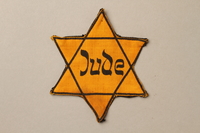
Star of David badge with Jude worn by a Jewish Czech woman
Object
Star of David badge worn by Elisabeth (Liese) Trausel in German occupied Prague following the September 1, 1941 order requiring Jews in Czechoslovakia to wear the Yellow Star of David badge at all times. The badge has pins sewn in to allow for easy removal from clothing so as to not be identified as a Jew. This allowed Liese to partake in actions that were prohibited for Jews such as crossing streets which were not open to Jews or taking trips by street car. Prague was invaded in March 1939, by Germany and made part of the Protectorate of Bohemia and Moravia. The authorities passed new anti-Jewish regulations that severely restricted Liese’s daily life. In September, Germany invaded neighboring Poland. In September 1941, Reinhard Heydrich became Reich Protector and soon there were almost daily deportations of Jews to concentration camps. Liese was married to a non-Jewish man and her daughters were considered half-Jewish, which exempted all three women from being transported. On December 13, 1942, Liese’s father Josef Polacek was facing deportation and instead committed suicide. In June and December 1943, many of the exemptions protecting particular groups were waived and more Jews were transported. On September 1, 1944, Liese was assigned to do compulsory work. Later that fall, she was transported to Theresienstadt ghetto-labor camp north of Prague. In April 1945, Hana was in the hospital and Eva was assigned to a compulsory work detail. Theresienstadt was taken over by the Red Cross on May 2, 1945. The war ended 5 days later when Germany surrendered. Liese returned to Prague. Many of her relatives and friends were killed in German concentration camps.
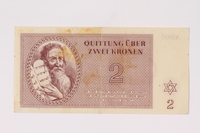
Theresienstadt ghetto-labor camp scrip, 2 kronen note acquired by a Jewish Czech woman
Object
Scrip valued at 2 kronen acquired by Elisabeth (Liese) Trausel who was imprisoned in Theresienstadt ghetto-labor camp from fall 1944 until liberation in May 1945. Liese lived in Prague when it was invaded in March 1939, by Germany and made part of the Protectorate of Bohemia and Moravia. The authorities passed new anti-Jewish regulations that severely restricted Liese’s daily life. In September, Germany invaded neighboring Poland. In September 1941, Liese was required to wear a yellow Star of David badge at all times to identify herself as Jewish. Later that month, Reinhard Heydrich became Reich Protector and soon there were almost daily deportations of Jews to concentration camps. Liese was married to a non-Jewish man and her daughters were considered half-Jewish, which exempted all three women from being transported. On December 13, 1942, Liese’s father Josef Polacek was facing deportation and instead committed suicide. In June and December 1943, many of the exemptions protecting particular groups were waived and more Jews were transported. On September 1, 1944, Liese was assigned to do compulsory work. Later that fall, she was transported to Theresienstadt ghetto-labor camp north of Prague. In April 1945, Hana was in the hospital and Eva was assigned to a compulsory work detail. Theresienstadt was taken over by the Red Cross on May 2, 1945. The war ended 5 days later when Germany surrendered. Liese returned to Prague. Many of her relatives and friends were killed in German concentration camps.

Theresienstadt ghetto-labor camp scrip, 5 kronen note acquired by a Jewish Czech woman
Object
Scrip valued at 5 kronen acquired by Elisabeth (Liese) Trausel who was imprisoned in Theresienstadt ghetto-labor camp from fall 1944 until liberation in May 1945. Liese lived in Prague when it was invaded in March 1939, by Germany and made part of the Protectorate of Bohemia and Moravia. The authorities passed new anti-Jewish regulations that severely restricted Liese’s daily life. In September, Germany invaded neighboring Poland. In September 1941, Liese was required to wear a yellow Star of David badge at all times to identify herself as Jewish. Later that month, Reinhard Heydrich became Reich Protector and soon there were almost daily deportations of Jews to concentration camps. Liese was married to a non-Jewish man and her daughters were considered half-Jewish, which exempted all three women from being transported. On December 13, 1942, Liese’s father Josef Polacek was facing deportation and instead committed suicide. In June and December 1943, many of the exemptions protecting particular groups were waived and more Jews were transported. On September 1, 1944, Liese was assigned to do compulsory work. Later that fall, she was transported to Theresienstadt ghetto-labor camp north of Prague. In April 1945, Hana was in the hospital and Eva was assigned to a compulsory work detail. Theresienstadt was taken over by the Red Cross on May 2, 1945. The war ended 5 days later when Germany surrendered. Liese returned to Prague. Many of her relatives and friends were killed in German concentration camps.
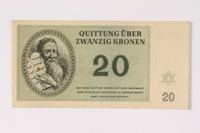
Theresienstadt ghetto-labor camp scrip, 20 kronen note acquired by a Jewish Czech woman
Object
Scrip valued at for 20 kronen acquired by Elisabeth (Liese) Trausel who was imprisoned in Theresienstadt ghetto-labor camp from fall 1944 until liberation in May 1945. Liese lived in Prague when it was invaded in March 1939, by Germany and made part of the Protectorate of Bohemia and Moravia. The authorities passed new anti-Jewish regulations that severely restricted Liese’s daily life. In September, Germany invaded neighboring Poland. In September 1941, Liese was required to wear a yellow Star of David badge at all times to identify herself as Jewish. Later that month, Reinhard Heydrich became Reich Protector and soon there were almost daily deportations of Jews to concentration camps. Liese was married to a non-Jewish man and her daughters were considered half-Jewish, which exempted all three women from being transported. On December 13, 1942, Liese’s father Josef Polacek was facing deportation and instead committed suicide. In June and December 1943, many of the exemptions protecting particular groups were waived and more Jews were transported. On September 1, 1944, Liese was assigned to do compulsory work. Later that fall, she was transported to Theresienstadt ghetto-labor camp north of Prague. In April 1945, Hana was in the hospital and Eva was assigned to a compulsory work detail. Theresienstadt was taken over by the Red Cross on May 2, 1945. The war ended 5 days later when Germany surrendered. Liese returned to Prague. Many of her relatives and friends were killed in German concentration camps.
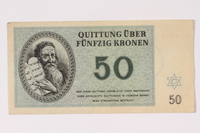
Theresienstadt ghetto-labor camp scrip, 50 kronen note acquired by a Jewish Czech woman
Object
Scrip valued at 50 kronen acquired by Elisabeth (Liese) Trausel who was imprisoned in Theresienstadt ghetto-labor camp from fall 1944 until liberation in May 1945. Liese lived in Prague when it was invaded in March 1939, by Germany and made part of the Protectorate of Bohemia and Moravia. The authorities passed new anti-Jewish regulations that severely restricted Liese’s daily life. In September, Germany invaded neighboring Poland. In September 1941, Liese was required to wear a yellow Star of David badge at all times to identify herself as Jewish. Later that month, Reinhard Heydrich became Reich Protector and soon there were almost daily deportations of Jews to concentration camps. Liese was married to a non-Jewish man and her daughters were considered half-Jewish, which exempted all three women from being transported. On December 13, 1942, Liese’s father Josef Polacek was facing deportation and instead committed suicide. In June and December 1943, many of the exemptions protecting particular groups were waived and more Jews were transported. On September 1, 1944, Liese was assigned to do compulsory work. Later that fall, she was transported to Theresienstadt ghetto-labor camp north of Prague. In April 1945, Hana was in the hospital and Eva was assigned to a compulsory work detail. Theresienstadt was taken over by the Red Cross on May 2, 1945. The war ended 5 days later when Germany surrendered. Liese returned to Prague. Many of her relatives and friends were killed in German concentration camps.
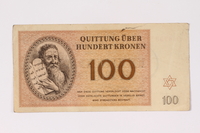
Theresienstadt ghetto-labor camp scrip, 100 kronen note acquired by a Jewish Czech woman
Object
Scrip valued at 100 kronen acquired by Elisabeth (Liese) Trausel who was imprisoned in Theresienstadt ghetto-labor camp from fall 1944 until liberation in May 1945. Liese lived in Prague when it was invaded in March 1939, by Germany and made part of the Protectorate of Bohemia and Moravia. The authorities passed new anti-Jewish regulations that severely restricted Liese’s daily life. In September, Germany invaded neighboring Poland. In September 1941, Liese was required to wear a yellow Star of David badge at all times to identify herself as Jewish. Later that month, Reinhard Heydrich became Reich Protector and soon there were almost daily deportations of Jews to concentration camps. Liese was married to a non-Jewish man and her daughters were considered half-Jewish, which exempted all three women from being transported. On December 13, 1942, Liese’s father Josef Polacek was facing deportation and instead committed suicide. In June and December 1943, many of the exemptions protecting particular groups were waived and more Jews were transported. On September 1, 1944, Liese was assigned to do compulsory work. Later that fall, she was transported to Theresienstadt ghetto-labor camp north of Prague. In April 1945, Hana was in the hospital and Eva was assigned to a compulsory work detail. Theresienstadt was taken over by the Red Cross on May 2, 1945. The war ended 5 days later when Germany surrendered. Liese returned to Prague. Many of her relatives and friends were killed in German concentration camps.
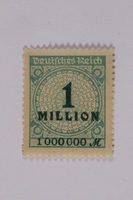
Postage stamp
Object
Elizabeth Trausel family collection
Document
The Elisabeth Trausel family collection consists of postcards sent to Elizabeth Trausel from relatives in the Theresienstadt ghetto. The contents of the postcards largely relate to receiving food parcels. The collection also includes ration cards issued in the ghetto, ghetto scrip, and a printed map of the ghetto.
Printed map of Theresienstadt Ghetto obtained by a Jewish Czech woman
Object
Single sided, printed, paper map of Theresienstadt ghetto labor camp acquired by Elisabeth (Liese) Trausel while imprisoned at the camp from late fall 1944 until liberation in May 1945. Liese was from Prague which was invaded in March 1939, by Germany and made part of the Protectorate of Bohemia and Moravia. The authorities passed new anti-Jewish regulations that severely restricted Liese’s daily life. In September, Germany invaded neighboring Poland. In September 1941, Liese was required to wear a yellow Star of David badge at all times to identify herself as Jewish. Later that month, Reinhard Heydrich became Reich Protector and soon there were almost daily deportations of Jews to concentration camps. Liese was married to a non-Jewish man and her daughters were considered half-Jewish, which exempted all three women from being transported. On December 13, 1942, Liese’s father Josef Polacek was facing deportation and instead committed suicide. In June and December 1943, many of the exemptions protecting particular groups were waived and more Jews were transported. On September 1, 1944, Liese was assigned to do compulsory work. Later that fall, she was transported to Theresienstadt ghetto-labor camp north of Prague. In April 1945, Hana was in the hospital and Eva was assigned to a compulsory work detail. Theresienstadt was taken over by the Red Cross on May 2, 1945. The war ended 5 days later when Germany surrendered. Liese returned to Prague. Many of her relatives and friends were killed in German concentration camps.
Permit to be out past curfew issued to a Jewish Czech woman
Object
Special pass issued to Elisabeth (Liese) Trausel by the Jewish Council of Prague granting her permission to be out on the streets before curfew expired on September 1, 1944. Liese was assigned to work as a mica splitter and in order to arrive on time she needed to leave before curfew ended. Prague was invaded in March 1939, by Germany and made part of the Protectorate of Bohemia and Moravia. The authorities passed new anti-Jewish regulations that severely restricted Liese’s daily life. In September, Germany invaded neighboring Poland. In September 1941, Liese was required to wear a yellow Star of David badge at all times to identify herself as Jewish. Later that month, Reinhard Heydrich became Reich Protector and soon there were almost daily deportations of Jews to concentration camps. Liese was married to a non-Jewish man and her daughters were considered half-Jewish, which exempted all three women from being transported. On December 13, 1942, Liese’s father Josef Polacek was facing deportation and instead committed suicide. In June and December 1943, many of the exemptions protecting particular groups were waived and more Jews were transported. On September 1, 1944, Liese was assigned to do compulsory work. Later that fall, she was transported to Theresienstadt ghetto-labor camp north of Prague. In April 1945, Hana was in the hospital and Eva was assigned to a compulsory work detail. Theresienstadt was taken over by the Red Cross on May 2, 1945. The war ended 5 days later when Germany surrendered. Liese returned to Prague. Many of her relatives and friends were killed in German concentration camps.
Sugar and coffee ration card stub issued to a Jewish Czech woman
Object
Ration card stub for nutrient and sugar, valid from September 18 – October 15, 1944, issued to Elisabeth (Liese) Trausel by the Ministry of Land and Forestry of Bohemia and Moravia. During the war food was strictly rationed in German controlled regions and Jews were allowed much smaller portions than the general public. To identify the owners as Jewish, the cards were first stamped with a large J and later the entire card was covered with inscriptions of “Jude’. Liese was from Prague, which was invaded in March 1939, by Germany and made part of the Protectorate of Bohemia and Moravia. The authorities passed new anti-Jewish regulations that severely restricted Liese’s daily life. In September, Germany invaded neighboring Poland. In September 1941, Liese was required to wear a yellow Star of David badge at all times to identify herself as Jewish. Later that month, Reinhard Heydrich became Reich Protector and soon there were almost daily deportations of Jews to concentration camps. Liese was married to a non-Jewish man and her daughters were considered half-Jewish, which exempted all three women from being transported. On December 13, 1942, Liese’s father Josef Polacek was facing deportation and instead committed suicide. In June and December 1943, many of the exemptions protecting particular groups were waived and more Jews were transported. On September 1, 1944, Liese was assigned to do compulsory work. Later that fall, she was transported to Theresienstadt ghetto-labor camp north of Prague. In April 1945, Hana was in the hospital and Eva was assigned to a compulsory work detail. Theresienstadt was taken over by the Red Cross on May 2, 1945. The war ended 5 days later when Germany surrendered. Liese returned to Prague. Many of her relatives and friends were killed in German concentration camps.
Sugar and coffee substitute ration card stub issued to a Jewish Czech woman.
Object
Ration card stub for coffee substitute valid from February 8 – March 71943, issued to Elisabeth (Liese) Trausel by the Ministry of Land and Forestry. During the war food was strictly rationed in German controlled regions and Jews were allowed much smaller portions than the general public. To identify the owners as Jewish the cards were first stamped with a large J and later the entire card was covered with inscriptions of “Jude’. Liese was from Prague, which was invaded in March 1939, by Germany and made part of the Protectorate of Bohemia and Moravia. The authorities passed new anti-Jewish regulations that severely restricted Liese’s daily life. In September, Germany invaded neighboring Poland. In September 1941, Liese was required to wear a yellow Star of David badge at all times to identify herself as Jewish. Later that month, Reinhard Heydrich became Reich Protector and soon there were almost daily deportations of Jews to concentration camps. Liese was married to a non-Jewish man and her daughters were considered half-Jewish, which exempted all three women from being transported. On December 13, 1942, Liese’s father Josef Polacek was facing deportation and instead committed suicide. In June and December 1943, many of the exemptions protecting particular groups were waived and more Jews were transported. On September 1, 1944, Liese was assigned to do compulsory work. Later that fall, she was transported to Theresienstadt ghetto-labor camp north of Prague. In April 1945, Hana was in the hospital and Eva was assigned to a compulsory work detail. Theresienstadt was taken over by the Red Cross on May 2, 1945. The war ended 5 days later when Germany surrendered. Liese returned to Prague. Many of her relatives and friends were killed in German concentration camps.
Bread and flour ration card stub issued to a Jewish Czech man
Object
Ration card stub for bread rolls, wheat or wheat flour valid from November 23 – December 20, 1942 issued to Josef Polacek by the Ministry of Land and Forestry. During the war food was strictly rationed in German controlled regions and Jews were allowed much smaller portions than the general public. To identify the owners as Jewish, the cards were first stamped with a large J and later the entire card was covered with inscriptions of “Jude’. Josef lived in Prague when it was invaded in March 1939 by Germany and made part of the Protectorate of Bohemia and Moravia. The authorities passed new anti-Jewish regulations that severely restricted Josef’s daily life. In September, Germany invaded neighboring Poland. In September 1941, Josef was required to wear a yellow Star of David badge at all times to identify himself as Jewish. Later that month, Reinhard Heydrich became Reich Protector and soon there were almost daily deportations of Jews to concentration camps. On December 13, 1942 Josef committed suicide rather than being deported east. On May 7, 1945 Germany surrendered, ending the war. Josef’s daughter, Elisabeth (Liese) Trausel and granddaughter, Hana Trausel (later Rehakova) survived the war.
Bread rolls and flour ration card stub issued to a Jewish Czech man
Object
Ration card stub for bread rolls, valid from July 6-August 2, 1942 issued to Josef Polacek by the Ministry of Land and Forestry. During the war food was strictly rationed and Jews were allowed much smaller portions than the general public. To identify them as Jewish the cards were first stamped with a large J and later the entire card was covered with inscriptions of “Jude’. Josef lived in Prague when it was invaded in March 1939, by Germany and made part of the Protectorate of Bohemia and Moravia. The authorities passed new anti-Jewish regulations that severely restricted Josef’s daily life. In September, Germany invaded neighboring Poland. In September 1941, Josef was required to wear a yellow Star of David badge at all times to identify himself as Jewish. Later that month, Reinhard Heydrich became Reich Protector and soon there were almost daily deportations of Jews to concentration camps. On December 13, 1942 Josef committed suicide rather than being deported east. On May 7, 1945 Germany surrendered, ending the war. Josef’s daughter, Elisabeth (Liese) Trausel and granddaughter, Hana Trausel (later Rehakova) both survived the war.
Potato ration card stub issued to a Jewish Czech man for potatoes
Object
Ration card stub for potatoes, valid from September 29 1941 – July 5 1942 issued to Josef Polacek by the Ministry of Land and Forestry. During the war food was strictly rationed in German controlled regions and Jews were allowed much smaller portions than the general public. To identify the owners as Jewish the cards were first stamped with a large J and later the entire card was covered with inscriptions of “Jude’. Josef lived in Prague when it was invaded in March 1939, by Germany and made part of the Protectorate of Bohemia and Moravia. The authorities passed new anti-Jewish regulations that severely restricted Josef’s daily life. In September, Germany invaded neighboring Poland. In September 1941, Josef was required to wear a yellow Star of David badge at all times to identify himself as Jewish. Later that month, Reinhard Heydrich became Reich Protector and soon there were almost daily deportations of Jews to concentration camps. On December 13, 1942 Josef committed suicide rather than being deported east. On May 7, 1945 Germany surrendered, ending the war. Josef’s daughter, Elisabeth (Liese) Trausel and granddaughter, Hana Trausel (later Rehakova) both survived the war.



